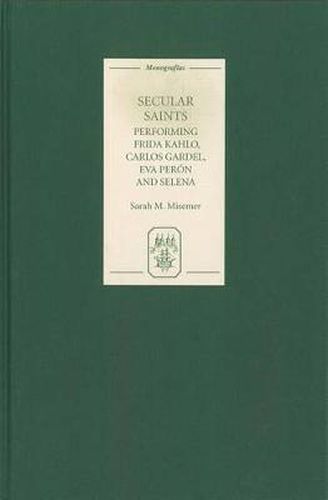Readings Newsletter
Become a Readings Member to make your shopping experience even easier.
Sign in or sign up for free!
You’re not far away from qualifying for FREE standard shipping within Australia
You’ve qualified for FREE standard shipping within Australia
The cart is loading…






Contemporary icons are drawn from popular culture - musicians, artists, actors, and other personalities we hear on radio or see on television, on screen, in print and in cyberspace. Today’s ‘gods’ are media personalities, and cults surround stars and artists like Frida Kahlo, Carlos Gardel, Eva Peron, and Selena. Because of transnational and global trends in importing and exporting cultural products, the paintings, music, and politics that these figures crafted accrue symbolic meaning in multiple formats. By viewing them through the lens of performance art we can begin to see how their polyvalent personas were first molded and perfected for the public through paintings, tangos, politics, and Tejano music. Once they fashioned their own complex images, these multi-layered icons continued to travel after death over international boundaries, gendered divisions, political borders, and language barriers. Their reincarnation on stage has allowed dramatists to affix and generate new associations, thus converting them into secular saints for contemporary audiences.
SARAH M. MISEMER lectures in Hispanic Studies at TexasA&M University, College Station.
$9.00 standard shipping within Australia
FREE standard shipping within Australia for orders over $100.00
Express & International shipping calculated at checkout
Contemporary icons are drawn from popular culture - musicians, artists, actors, and other personalities we hear on radio or see on television, on screen, in print and in cyberspace. Today’s ‘gods’ are media personalities, and cults surround stars and artists like Frida Kahlo, Carlos Gardel, Eva Peron, and Selena. Because of transnational and global trends in importing and exporting cultural products, the paintings, music, and politics that these figures crafted accrue symbolic meaning in multiple formats. By viewing them through the lens of performance art we can begin to see how their polyvalent personas were first molded and perfected for the public through paintings, tangos, politics, and Tejano music. Once they fashioned their own complex images, these multi-layered icons continued to travel after death over international boundaries, gendered divisions, political borders, and language barriers. Their reincarnation on stage has allowed dramatists to affix and generate new associations, thus converting them into secular saints for contemporary audiences.
SARAH M. MISEMER lectures in Hispanic Studies at TexasA&M University, College Station.